
Wild West Yorkshire, Monday 18 October 2010
previous | this month | next

Langsett Reservoir lies beside the busy A616 Sheffield to Manchester road but you've only to walk down to the waterside trail to find yourself overlooking the Dark Peak moors that stretch away to the reservoirs of the Derwent Valley and to the Snake Pass, eight miles to the south-west.
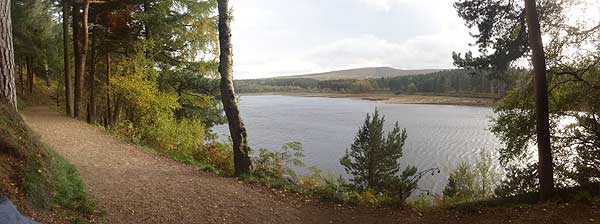
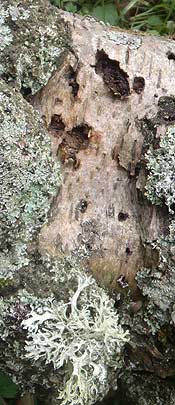
 Last month, we were walking around Kielder Water, Britain's largest reservoir set in England's largest forest but Langsett gives us a chance to enjoy the same kind of scenery on a smaller scale and just half an hour's drive from home. You can find some of same wild-looking textures you'd find on a walk at Kielder, for instance in the lichen on this birch log. The log was pitted with holes, which looked like the work of a woodpecker.
Last month, we were walking around Kielder Water, Britain's largest reservoir set in England's largest forest but Langsett gives us a chance to enjoy the same kind of scenery on a smaller scale and just half an hour's drive from home. You can find some of same wild-looking textures you'd find on a walk at Kielder, for instance in the lichen on this birch log. The log was pitted with holes, which looked like the work of a woodpecker.
I pick up some cones to draw later. There are three main types of conifer cone here:
Spruce (right) has a cone that reminds me of the weights that hang on chains from a cuckoo-clock. The Norway spruce is the traditional Christmas tree.
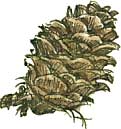 Larch has small tufts of yellow male flowers which hang down from the branches while the pink female flowers point upwards and develop into the seed-bearing cones (left).
Larch has small tufts of yellow male flowers which hang down from the branches while the pink female flowers point upwards and develop into the seed-bearing cones (left).
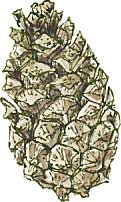 The female cones of pine (right) are large and woody. Crossbills, which we've seen both here and at Kielder, have specially adapted beaks to tweak out the seeds that develop inside.
The female cones of pine (right) are large and woody. Crossbills, which we've seen both here and at Kielder, have specially adapted beaks to tweak out the seeds that develop inside.

![]() Since I drew these cones they've dried and opened up. The pine has shed just one seed (left), while the larch has shed dozens (above).
Since I drew these cones they've dried and opened up. The pine has shed just one seed (left), while the larch has shed dozens (above).
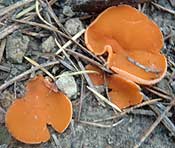
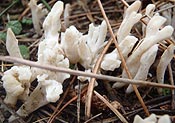 Wrinkled Club and Orange Peel
Wrinkled Club and Orange PeelThis orange peel fungus, Aleuria aurantia, was growing on pine needles by the path, as was wrinkled club fungus, Clavulina rugosa, growing not much more than an inch high.
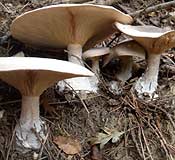
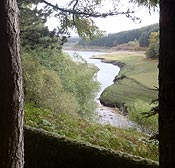 These more familiar looking toadstools (left) were growing on a banking which is where I remember photographing fly agaric last year.
These more familiar looking toadstools (left) were growing on a banking which is where I remember photographing fly agaric last year.
![]()
![]()
![]() The reservoir seems to be running low at the moment. A group of mallards are standing on the exposed banking near the waters edge while 13 wigeons swim on the still extensive open water.
The reservoir seems to be running low at the moment. A group of mallards are standing on the exposed banking near the waters edge while 13 wigeons swim on the still extensive open water.
Both mallards and wigeons are dabbling ducks. Their legs are near the middle of their bodies, making it easier for them to come out on to land, the mallards to loaf about at the water's edge, the wigeons to graze in flocks on short grass. Wigeon are a favourite target for wildfowlers, which might explain why, this afternoon, they appear more cautious than the mallards.
Richard Bell, illustrator
previous | this month | Wild West Yorkshire home page | next